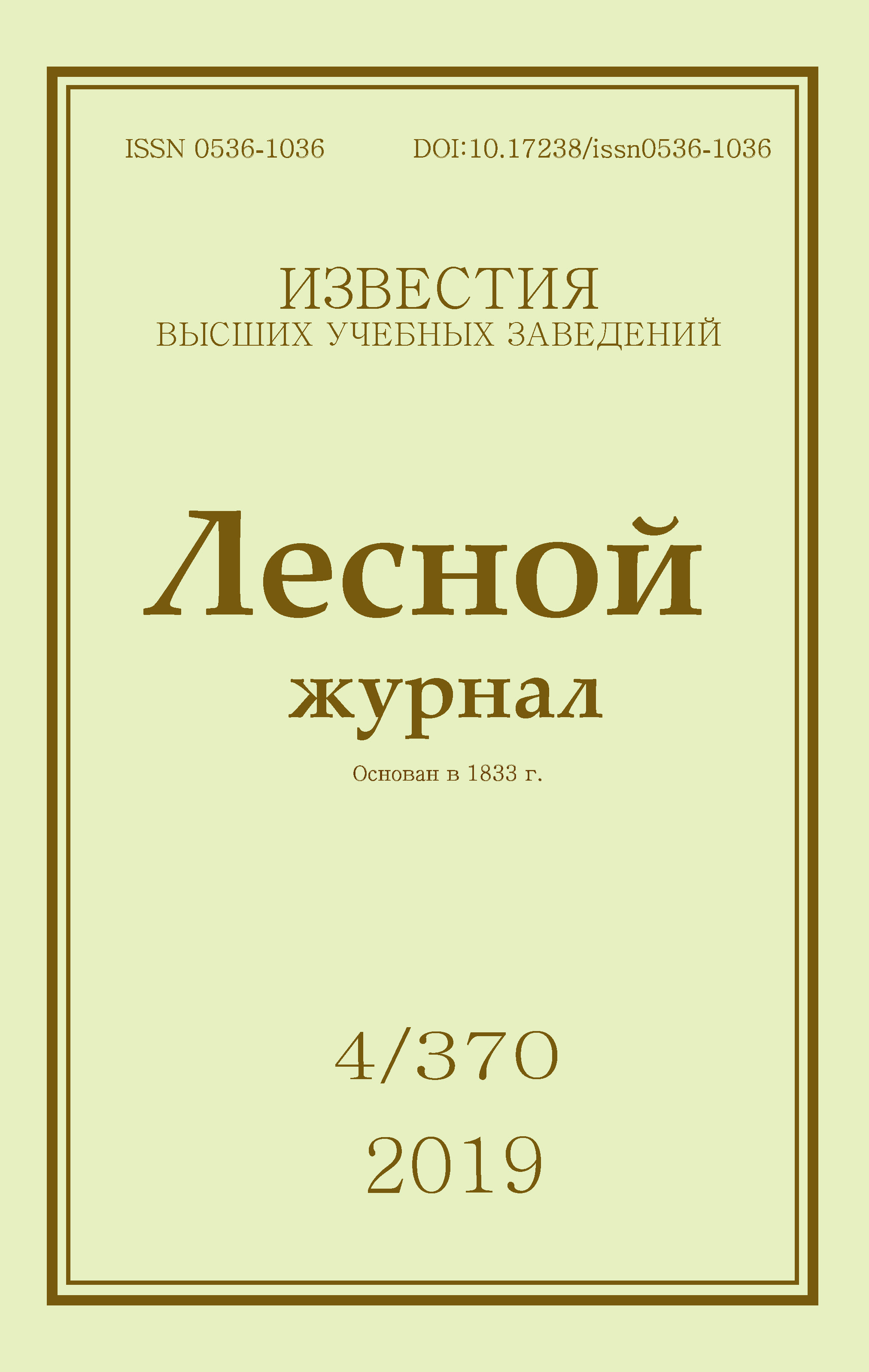Toropov. Lumber Production for Construction from Round Timber with Heart Rot
DOI:
https://doi.org/10.17238/issn0536-1036.2019.4.133Keywords:
round timber, heart rot, allometric growth equations, solid wood I-beam, angle bars, lumber useful output for building structuresAbstract
Coniferous lumber is popular in low-rise wooden house construction. However, the condition of round timber for lumber production has been going down in recent years. Timber with heart rot is very common nowadays. As a rule, the heart rot removal occurs in harvesting of round timber. At the same time, disease-free sap wood is removed together with the wood affected by the rot in timber cutting. Therefore, a large amount of sound timber remains in forest. Cutting of timber with rot reduces the yield of lumber for construction, as far as rot’s presence in building structures is not allowed. A method of cutting round timber with heart rot is proposed for the purposes of production I-beams from solid wood. It is necessary to know the form and sizes of rot for high-quality rough ripping of round timber with heart rot. The relationship between the cross-sectional dimensions of round timber and heart rot along the length of assortments is quite accurately described by the equations of correlative (allometric) growth. The schemes of cutting round timber with heart rot have been developed taking into account these dependencies. Cutting was carried out by split-pith sawing scheme. Firstly, two four-side edged cants with heart rot in the central part of one of the cross-section layers were produced. Then the beams were longitudinally divided into two parts. Rot was removed from these parts by milling. Angle bars for I-beams production were obtained as a result of conditional cutting of pine round timber. The studies of the I-beam made of angle bars were carried out. The calculated stresses of beam bending do not exceed the accepted values. The useful output of such bars made of round timber with heart rot is calculated. It has been found that the method of manufacturing elements of building constructions from round timber with heart rot will allow to use them in low-rise wooden house construction. This will expand the wood resources for construction.
For citation: Toropov A.S., Byzov V.E., Toropov S.A. Lumber Production for Construction from Round Timber with Heart Rot. Lesnoy Zhurnal [Forestry Journal], 2019, no. 4, pp. 133–145. DOI: 10.17238/issn0536-1036.2019.4.133
Downloads
References
Воронцова Н.А., Филатов Н.В., Шестопалов Е.Г. Использование клеефанерных элементов с перфорированными стенками в конструкциях малоэтажных деревянных зданий // Вологдинские чтения. 2012. № 80. С. 74–76.
ГОСТ 8486–86. Пиломатериалы хвойных пород. Технические условия. Введ. 1988–01–01. М.: Стандартинформ, 2007. 7 с.
Карельский А.В., Журавлева Т.П., Лабудин Б.В. Испытание на изгиб деревянных составных балок, соединенных металлическими зубчатыми пластинами, разрушающей нагрузкой // Инж.-строит. журн. 2015. № 2(54). С. 77–85. DOI: 10.5862/MCE.54.9
Кузнецов И.Л., Крайнов И.В., Гимранов Л.Р. Усиление клеефанерных двутавровых балок // Изв. Казан. ГАСУ. 2015. № 4(34). С. 166–170.
Литовченко П., Молошный В., Елькина И., Литовченко С. Экспериментальное исследование двутавровых деревянных балок // MOTROL. 2009. 11В. С. 145–151.
Михайленко О.А., Кожевникова М.С. О влиянии анизотропии упругих свойств древесины и фанеры на напряженно-деформированное состояние комбинированных конструкций // Технические науки – от теории к практике: сб. ст. по материалам LXIII междунар. научн.-практ. конф. № 10(58). Новосибирск: СибАК, 2016. С. 118–126.
Огурцов В.В., Каргина Е.В., Матвеева И.С. Зависимость объемного выхода пиломатериалов от дробности сортировки бревен по толщине // Хвойные бореальной зоны. 2013. № 5-6. С. 71–75.
Синцов А.В., Синцов В.П. Прочность и деформативность составной деревянной балки со стенкой из ориентированной стружечной плиты // Строительство и техногенная безопасность. 2014. № 50. С. 152–158.
СП 64.13330.2017. Деревянные конструкции. Актуализированная редакция СНиП II-25–80. Введ. 2017–08–28. М.: Минстрой России, 2017. 97 с.
Торопов А.С. Исследование предмета труда лесоэксплуатации: метод. указания. Йошкар-Ола: МарГТУ, 1995. 16 с.
Торопов А.С., Торопов С.А., Микрюкова Е.В. Исследование пораженности древесины напенной гнилью // Лесн. журн. 2009. № 4. С. 95–100. (Изв. высш. учеб. заведений).
Туснин А.Р., Прокич М. Экспериментальные исследования работы балок двутаврового сечения при действии изгиба и кручения // Инж.-строит. журн. 2015. № 1(53). С. 24–31. DOI: 10.5862/MCE.53.3
Aro M., Brashaw B.K., Donahue P.K. Mechanical and Physical Properties of Thermally Modified Plywood and Oriented Strand Board Panels // Forest Products Journal. 2014. Vol. 64, iss. 7-8. Pp. 281–289. DOI: 10.13073/FPJ-D-14-00037
Benjeddou O., Limam O., Ouezdou M.B. Experimental and Theoretical Study of a Foldable Composite Beam // Engineering Structures. 2012. Vol. 44. Pp. 312–321. DOI: 10.1016/j.engstruct.2012.06.011
BS EN 338:2003. Structural Timber. Strength Classes. BSI, 2003. 14 p.
Challamel N., Girhammar U.A. Lateral-Torsional Bucking of Vertically Layered Composite Beams with Interlayer Slip under Uniform Moment // Engineering Structures. 2012. Vol. 34. Pp. 505–513. DOI: 10.1016/j.engstruct.2011.10.004
Davis P.M., Gupta R., Sinha A. Revisiting the Neutral Axis in Wood Beams // Holzforschung. 2012. Vol. 66. Pp. 497–503. DOI: 10.1515/HF.2011.180
Fernando D., Frangi A., Kobel P. Behavior of Basalt Fiber Reinforced Polymer Strengthened Timber Laminates under Tensile Load // Engineering Structures. 2016. Vol. 117. Pp. 437–456. DOI: 10.1016/j.engstruct.2016.03.009
Harte A.M., Baylor G. Structural Evaluation of Castellated Timber I-Joists // Engineering Structures. 2011. Vоl. 33, iss. 12. Pp. 3748–3754. DOI: 10.1016/j.engstruct. 2011.08.011
Hu C., Xiao M., Zhou H., Wen W., Yun H. Damage Detection of Wood Beams Using the Differences in Local Modal Flexibility // Journal of Wood Science. 2011. Vol. 57. Pp. 479–483. DOI: 10.1007/s10086-011-1200-3
Khorsandnia N., Valipour H.R., Crews K. Nonlinear Finite Element Analysis of Timber Beams and Joints Using the Layered Approach and Hypoelastic Constitutive Law // Engineering Structures. 2013. Vol. 46. Pp. 606–614. DOI: 10.1016/j.engstruct.2012.08.017
O’Loinsigh C., Oudjene M., Shotton E., Pizzi A., Fanning P. Mechanical Behavior and 3D Stress Analysis of Multi-Layered Wooden Beams Made with Welded-Through Wood Dowels // Composite Structures. 2012. Vol. 94, iss. 2. Pp. 313–321. DOI: 10.1016/j.compstruct.2011.08.029
Yoshihara H. Bending Properties of Medium-Density Fiberboard and Plywood Obtained by Compression Bending Test // Forest Products Journal. 2011. Vol. 61, no. 1. Pp. 56–63. DOI: 10.13073/0015-7473-61.1.56
Поступила 25.02.19







